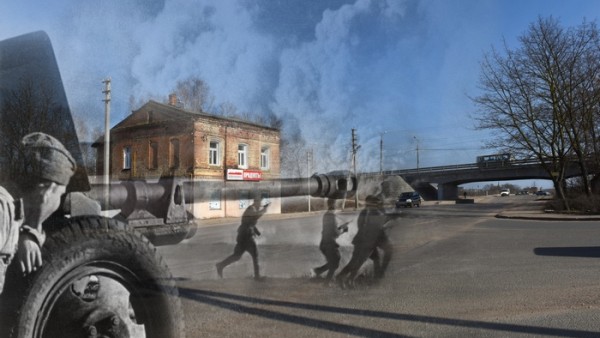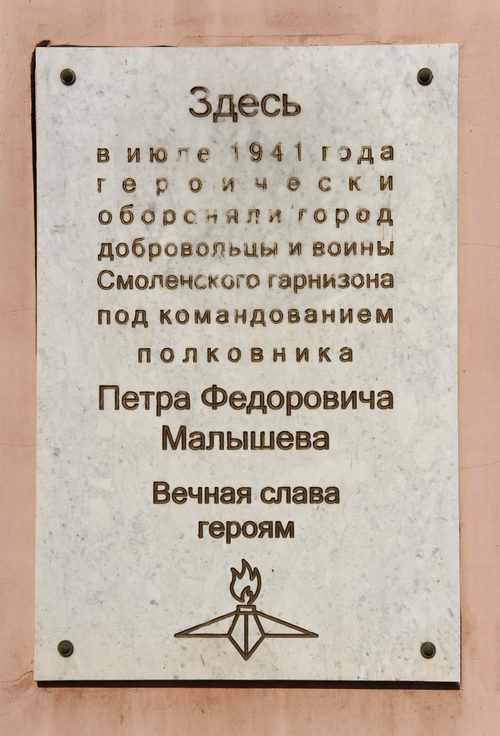There is a wrong mess in Smolensk «pot»

In the essay-guidebook «The Hero-city Smolensk» while noticing places, that are related to the struggle against the Nazi, there is a reference to the building of «the grocery store in the Bolshaya Krasnoflotskaya street near the New bridge over the Dnieper.»
It should be said that during the war time the issue of food supplies was very serious. When Hitler planned to occupy the Smolensk territory, he wanted to destroy the enemy army quickly and to create a base for Moscow attacking. During the battle, crops, livestock, food stores were either destroyed or captured by the enemy and used to meet the own needs. As a result, there appeared a catastrophic food situation in the military units and peaceful territories very quickly.
«When the war started, my great-grandmother, Zueva Gera Andreevna with her two sisters and her mother remained in the occupation in Smolensk. My great-grandmother was 12 years old, and her sisters were 9 and 6 years old. Smolensk was bombed heavily at the beginning of the war. My great-grandmother and others hid in the cathedral of Smolensk, the Germans did not bomb it. Next to the cathedral there was the pasta factory, that had a lot of flour and molasses at the time. When the Nazis came to the town, the bombing stopped. The great-grandmother and her family returned to their home. During the German occupation, the life was very difficult, there was nothing there. Children had to ask Germans for some food. Once they got the pig skin at meat factory. On the way back they met a German. The children got scared, but the German was the good one. He took and threw the skin away, explained that it could not be eaten, and gave them three loaves of bread and a pot of soup «- this is what writes about the war one of the pupil’s of the 7th form in one of the Smolensk schools. Tanker Alexander Golikov, being surrounded, wrote to his wife: «We do not have even water bottles, there is nothing to pour the water in, we eat from time to time, and sleep in the places, I couldn’t even believe before. The heat, the dirt and the terrible fatigue. »
Next to the above mentioned house number 4 in the Bolshaya Krasnoflotskaya street (now is an object of cultural heritage of regional significance «The House with the bench»), there is a memorable place, where the Smolensk militia kept the defense against the advancing Nazi troops.
The backbone of Russian troops operating in the area of Smolensk, were the forces of the 16th Army. It consisted of 32th Infantry Corps, consisting of the 46th and 152th Infantry Division. In the night from 22 to 23 July in the area of the cemetery in the joint 129th and 152nd infantry divisions there were severe street fightings. After a short but powerful artillery attack, the 152th infantry Division went on the offense. The division parts broke into Smolensk at its territory and began to liberate slowly, but surely the house to house, block by block, street by street. In Smolensk «pot» — the Nazi propagandists trumpeted about it around the whole world – the was the wrong mess, as the Hitler commands wanted. The German soldiers were puzzled, how could the Russians in the conditions of chaos and hunger so persistently and fearlessly try to attack the German positions. The Germans wrote: «The Russians fight till the last breath, even wounded do not let us to themselves. The one Russian sergeant, unarmed, and with a terrible wound in his shoulder, went at us with a pioneer spade. Madness, it is the real madness. They fight like animals». From the German’s point of view the opposition in the Smolensk region for the first time broke Hitler’s plans. In a heavy fighting bogged down 11 enemy divisions, aimed to Moscow. Battle of Smolensk was held from July 10 to September 10, 1941. Its main result was the delay of the German’s offensive on the capital. The «Barbaross» plan: a sudden blow, lightning war – a serious breach, as a result. The army near Smolensk made a great feat and people would not forget it. A strong movement, made by the enemy, was thrown here. Smolensk showed (and later Moscow proved!) that the blitzkrieg wasn’t released.
The memorial where the Smolensk militia kept the defense against the Nazi troops, is an object of cultural heritage of regional significance. At the house number 4 in the Bolshaya Krasnoflotskaya street there is a memorial plaque with the text: «Here in July 1941, volunteers and soldiers of the garrison under Colonel Peter Fedorovich Malyshev defended the city of Smolensk heroically. Eternal glory to the heroes. »


